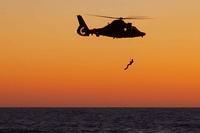The U.S. Air Force says development of a new aircraft made by Boeing Co. to replace a portion of its refueling tanker fleet is moving forward as planned.
The service plans to spend $52 billion buying 179 of the so-called KC-46A aircraft, a derivative of the 767 twin-engine jet airliner, to replace a third of its fleet of Cold War-era KC-135 Stratotankers, also made by the Chicago-based company.
The program on Aug. 21 verified the plane's engineering specifications as part of an acquisition milestone known as critical design review is a month ahead of schedule.
"Everything is coming together really well," Acting Air Force Secretary Eric Fanning said in a statement.
Maj. Gen. John Thompson, who oversees development of the aircraft from Wright-Patterson Air Force Base in Ohio, is scheduled to discuss the program Sept. 17 during the Air Force Association's annual conference in National Harbor, Md., just south of Washington, D.C.
Analysts said they're not expecting any big surprises from the briefing.
While the Defense Department faces another round of automatic budget cuts known as sequestration, officials have repeatedly cited the tanker program as a priority because of the need to replace the aging and maintenance-prone KC-135 aircraft, which entered service in the mid-1950s.
"This isn't one of those programs that's experimental and may be good to have but can be sacrificed," Douglas Royce, an aircraft analyst at Forecast International, a market research firm in Newtown, Conn., said in a telephone interview. "It's completely necessary for what the Air Force and Navy do in terms of their missions around the world."
The fleet of existing tankers provides aerial refueling for the vast majority of aircraft flown by the U.S. military and allied forces. The planes are also used to transport patients for emergency medical evacuations.
Boeing in 2011 beat European Aeronautic, Defence & Space Co. for the contract. It was Boeing's third bid for the work in almost a decade. The original agreement was canceled in 2004 amid a scandal involving Boeing's chief financial officer, Michael Sears, who offered a job to the Air Force's top procurement official, Darleen Druyun, during negotiations. Both were sentenced to serve jail time.
"No matter what, the program will survive," Royce said. "The question is really how many aircraft get built in any given year."
Production of the new tanker is expected to ramp up to 18 planes a year by 2018, Royce said. The work will help Boeing keep the 767 line open for the foreseeable future, he said. The aircraft is nearing the end of its run as a commercial airliner as newer and more fuel-efficient planes such as Boeing's 787 Dreamliner enter service, he said.
While international demand for the military plane won't be anywhere near the size of the U.S. market, Boeing has already begun courting potential foreign buyers.
Company officials have had discussions with several possible customers in the Middle East and Asia-Pacific regions about starting deliveries as early as 2017, according to Chris Raymond, vice president of business development and strategy for Boeing's defense, space and security unit, and Jeff Kohler, vice president of international business development for the unit.
"There are discussions going on with a number of people," Raymond said during a June 16 press conference at the company's Paris office before the start of the Paris Air Show.
Boeing can't finalize the deals until it delivers the first tranche of planes to the Air Force. The company is under contract to deliver 18 of the aircraft by August 2017 and the remainder by 2027.
Government auditors have found the cost of developing the first four planes will exceed the contract ceiling price of $4.9 billion, according to a February report from the Government Accountability Office, the investigative arm of Congress. They also determined that Boeing already used the vast majority of a reserve budget for development risks, even though five years' worth of work remains.
"Significant use of these funds early in a program may indicate problems," the report states.
Royce, the market analyst, said any development challenges will probably come from the mission systems – not the airframe, which Boeing has been building for more than three decades.
"Because it's based on an existing airliner, the aircraft is not where you're going to have a problem," he said. "Boeing knows how to build a 767. It's a stable design. It's when you start testing the aircraft with mission equipment -- the aerial refueling system, boom, hose, drogue -- where you would expect issues to arise."
The Air Force requested $1.56 billion for the program in fiscal 2014, which begins Oct. 1, a decrease of 14 percent from the previous year, according to Pentagon budget documents.
The service has said two aircraft in production at Boeing's plant in Everett, Wash., will be ready for flight testing in mid-2014. The first fully equipped plane -- outfitted with such mission equipment as a refueling operating station, boom refueling systems and defensive weapons -- is scheduled to fly in early 2015.
The Air Force has already selected Altus Air Force Base, Okla., McConnell Air Force Base, Kan., and Pease Air National Guard Base, N.H., as the first three bases to station the new refueling tanker.




























